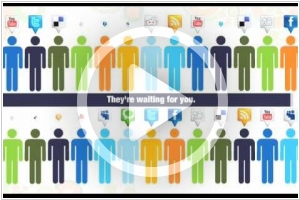Salesforce is #1 in Top 10 Online CRM software
Most-popular CRM. Easy collaboration. Proven cloud platform. Salesforce.com offers everything you need to transform your business into a Social Enterprise, so you can connect to customers and employees like never before. With no software or hardware to install, you're up and running—and seeing a positive impact on your business—quickly.
Positions in ratings
#1 in Top 10 Online CRM software
#1 in Top 16 Helpdesk software
#1 in Top 20 Marketing software
Alternatives
The best alternatives to Salesforce are: SAP CRM, HubSpot, ServiceNow, Zoho CRM, Zendesk, Microsoft Dynamics 365, Oracle Sales
Latest news about Salesforce
2023. Salesforce to acquire Airkit.ai, a low-code platform for building AI customer service agents
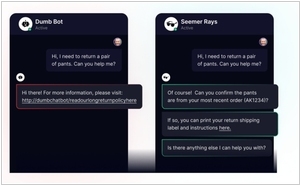
Salesforce is set to acquire Airkit.ai, a low-code platform designed to assist e-commerce enterprises in constructing AI-driven customer service agents. Initially conceived as a self-serve customer engagement platform, Airkit facilitated the integration of data silos and addressed various use cases like user onboarding. However, in a recent rebranding move, the company transformed into Airkit.ai and unveiled its inaugural integrated product, a GPT-4-powered platform enabling businesses like OpenTable and ShipBob to develop customized customer service chatbots capable of handling inquiries related to order status, refunds, product information, and more.
2023. Salesforce launches AI Cloud to bring models to the enterprise
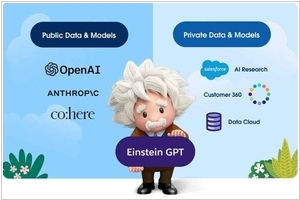
Salesforce is introducing a new collection of products with the goal of strengthening its position in the highly competitive field of AI. This suite, known as AI Cloud, consists of tools that are designed to provide AI solutions that are suitable for enterprise use. It represents Salesforce's latest effort to enhance its product lineup with AI capabilities across different disciplines. The launch of AI Cloud builds upon the company's previous generative AI initiative, which was introduced in March, aiming to incorporate generative AI throughout the entire Salesforce platform. AI Cloud serves as a hosting and delivery platform for AI models, specifically those focused on generating text, from a variety of partners such as Amazon Web Services, Anthropic, Cohere, and OpenAI. Additionally, Salesforce's own AI research division offers first-party models that power features like code generation and business process automation. Customers also have the option to bring their own custom-trained models to the platform while storing their data on their own infrastructure.
2020. Salesforce announces new Service Cloud workforce planning tool
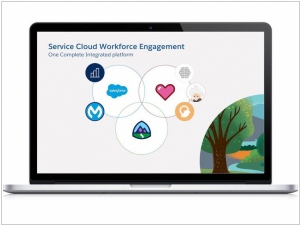
With a pandemic wreaking havoc in various parts of the globe, numerous companies are confronted with the challenge of managing dispersed customer service agents, leading to a complex workforce management situation. To address this issue, Salesforce is in the process of developing a new product called Service Cloud Workforce Engagement. Much like other Salesforce offerings, this solution comprises several crucial elements that work together to provide a comprehensive answer. Firstly, there is Service Forecast for Customer 360, a tool that utilizes AI to anticipate workforce requirements and intelligently allocate customer service requests. Furthermore, there is Omnichannel Capacity Planning, which aids managers in assigning customer service agents to channels like phone, messaging, or email based on the prevailing demand. Lastly, there is a training component designed to coach customer service agents on delivering accurate and appropriate responses tailored to specific situations.
2020. Salesforce applies AI to workflow with Einstein Automate
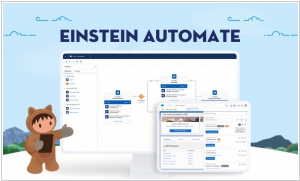
Salesforce has unveiled Einstein Automate, a new collection of workflow solutions powered by artificial intelligence (AI). Einstein serves as Salesforce's AI platform, encompassing all aspects of the company's product portfolio. It introduces automation to various tasks and simplifies the process of extracting valuable customer information, which often gets buried within vast amounts of data. Furthermore, Salesforce is incorporating MuleSoft, an integration company it acquired for $6.5 billion in 2018, into its offerings. This integration enables IT professionals to effortlessly build intricate connections between applications across the enterprise and the Salesforce suite of products, enhancing processes like mortgage approval workflows and more.
2020. Salesforce beefing up field service offering with AI
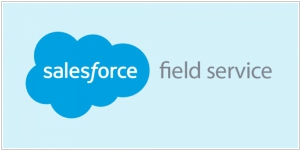
Salesforce is introducing AI-powered enhancements to its field service offerings, leveraging the capabilities of artificial intelligence. One of the key additions is Dynamic Priority, which allows the machine to set repair priorities based on factors such as service agreement type and criticality, streamlining call organization and enabling dispatchers to focus on other tasks. Furthermore, Salesforce aims to provide customers with a similar experience to tracking a driver's progress in a rideshare app. The introduction of Appointment Assistant, a new application, empowers customers to track the arrival time of their assigned repair person, ensuring they are aware of when to expect them.
2020. Salesforce announces a new mobile collaboration tool for sales called Anywhere
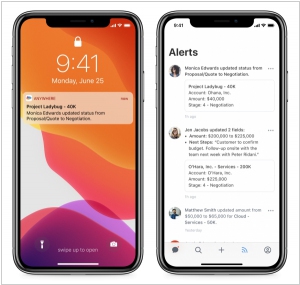
Salesforce has introduced a new tool called Salesforce Anywhere with the purpose of facilitating collaboration and data sharing among teams, regardless of their location. Recognizing the increasing significance of collaboration in a digital environment during the pandemic, the development of such an application became crucial for the company. The primary objective is to go beyond the confines of a traditional database and enable salespeople to access the most relevant information based on their sales pipelines. This tool allows employees to share information within their teams and engage in discussions related to that specific data. While there are other chat tools available, Salesforce Anywhere is specifically tailored for sharing Salesforce data, distinguishing it from more general-purpose platforms like Slack or other business chat tools.
2018. Salesforce allows to enter data to CRM via voice

Sales managers are renowned for their verbal prowess, as talking is an integral part of their job. However, when it comes to entering customer data into a CRM system, they are faced with the arduous task of typing. Salesforce aims to alleviate this cognitive dissonance by introducing a new feature called Einstein Voice. This feature enables users to input data into the system effortlessly using natural speech. Just imagine, you hop into your car, open the mobile app, and have a conversation with a virtual assistant. You might say, "I just had a meeting with John Smith. He expressed interest in making a purchase but requested a follow-up call in a week...". The virtual assistant then dutifully adds a note to the customer's history in the CRM system. However, Salesforce might need to address the personality of their virtual assistant. It seems incongruous to task Einstein with such mundane responsibilities.
2018. Salesforce released new product - Customer 360
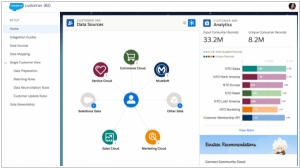
Customer 360 is an innovative software that integrates various customer data components to provide a more cohesive view within the Salesforce product family. Leveraging technology from Salesforce's Mulesoft acquisition, this solution aims to empower customer service representatives by equipping them with a comprehensive understanding of your interactions with the company. By eliminating the need for redundant information sharing, the representative can address your needs more effectively. The primary objective is to consolidate different product functionalities—such as sales, service, community, commerce, and marketing—into a unified customer view. Remarkably, this can be achieved without the need for coding, as highlighted by Salesforce.
2018. Salesforce simplifies phone sales
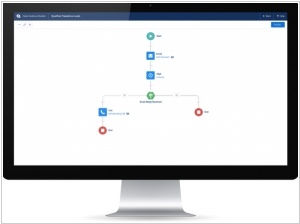
Salesforce has recently introduced updates to its core Sales Cloud, focusing on automation and integration. One of the key enhancements is the simplification of inside phone sales, where the sales team is provided with a prioritized list of calls based on conversion likelihood. Moreover, the team is guided through a sales process that aligns with management-defined best practices. High Velocity Sales leverages Salesforce Einstein's underlying intelligence to optimize the sales process, increasing the chances of converting prospects. This includes determining contact frequency and tailoring content. For phone calls, this might involve providing call scripts with suggested dialogue for engaging prospects. For emails, it may offer relevant information aimed at moving the prospect closer to a sale, along with recommendations on email frequency. As the sales team progresses towards closing deals, Salesforce CPQ (configure, price, quote) capabilities come into play. Originally stemming from the company's acquisition of SteelBrick, this product receives an exciting update for Dreamforce this year.
2018. Salesforce introduces Integration Cloud on heels of MuleSoft acquisition
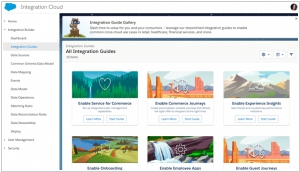
One week following the acquisition of MuleSoft, Salesforce has unveiled Integration Cloud, a solution built upon the acquired technology. Integration Cloud comprises three main components: the Integration Platform, which will ultimately be powered by MuleSoft; Integration Builder, a tool that enables the consolidation of comprehensive customer profiles from various Salesforce tools and enterprise data repositories; and Integration Experiences, designed to assist brands in creating personalized experiences by leveraging insights from the aforementioned tools. Currently, Integration Cloud includes a few elements independent of MuleSoft, such as Lightning Flow, a workflow tool enabling Salesforce customers to build workflows utilizing customer data stored in Salesforce CRM.
2018. Salesforce is buying cloud integration provider MuleSoft
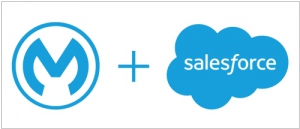
In a significant move, Salesforce has announced its acquisition of MuleSoft in a deal worth $6.5 billion. Salesforce has expressed interest in MuleSoft for quite some time, and this acquisition provides the CRM giant with a well-established company boasting 1,200 customers. Beyond the customer base, Salesforce gains access to MuleSoft's robust API integration engine, enabling seamless data connectivity across organizations, regardless of its location. This capability holds particular significance for Salesforce as it collaborates with companies across various enterprise systems. As Salesforce expands its artificial intelligence and machine learning capabilities, branded as Einstein, having access to comprehensive data throughout the organization becomes crucial. MuleSoft's integration solutions fulfill this need. In addition to the technology, Salesforce also benefits from the integration of MuleSoft into its ever-growing product portfolio. Furthermore, this acquisition brings major customers like Coca-Cola, VMware, GE, Accenture, Airbus, AT&T, and Cisco under the Salesforce umbrella, further solidifying its market presence.
2018. Salesforce launched CRM for small business - Essentials
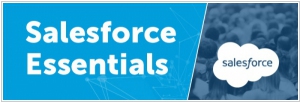
Salesforce has had limited presence in the small business market, and this holds true for many of its CRM competitors as well. Within this market segment, many companies have relied on Microsoft products such as Outlook and Excel instead of dedicated CRM solutions. The primary factors driving this choice have been cost considerations, familiarity, and ease of use. To address this, Salesforce has launched a new product called Salesforce Essentials, priced at $25 per user per month. It encompasses essential CRM features, including the integration of Einstein Artificial AI to enhance productivity, alongside the Salesforce Trailhead online learning platform, which simplifies the user experience. Additionally, Salesforce Essentials customers are eligible for a promotional offer resulting from Salesforce's partnership with Google. This offer grants them three months of G Suite by Google Cloud at no additional cost.
2018. Salesforce acquires enterprise e-commerce startup CloudCraze
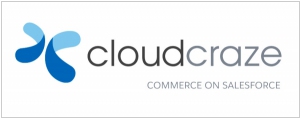
Salesforce has announced its acquisition of CloudCraze, an enterprise e-commerce solution that operates on Salesforce's cloud-based customer relationship management platform. This acquisition allows Salesforce and its customers to tap into the growing trend of digital commerce, enabling businesses to seamlessly browse and make online purchases, mirroring the convenience experienced by consumers. CloudCraze marks Salesforce's second acquisition this year, following the acquisition of Attic Labs in January.
2018. Salesforce added automated query building feature in Einstein Analytics
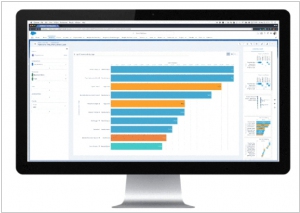
Salesforce has introduced a new feature called Einstein Analytics Conversational Queries, which enhances the user experience by recognizing commonly used phrases as they are being typed. This automated functionality simplifies the process of building queries and accessing data. With Conversational Queries, users can effortlessly type phrases related to their data, such as "show me top accounts by annual revenue" or "rank accounts decreasing by annual revenue and billing country," and instantly visualize the results in dynamically configured charts. By enabling queries in plain language, automatically assisting in query construction, and generating charts based on the recognized phrases, this feature expands the accessibility of analytics to a broader user base.
2016. Salesforce adds messaging to Service Cloud
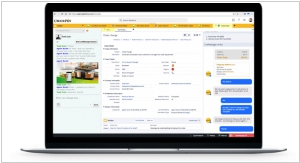
Salesforce has unveiled LiveMessage, a powerful tool integrated into Service Cloud that empowers customer service representatives to efficiently handle messaging traffic alongside other customer interactions. LiveMessage currently offers support for SMS/MMS and Facebook Messenger, with plans to expand its capabilities to include additional messaging applications in the coming year. This new functionality is the result of Salesforce's acquisition of HeyWire in September, leveraging the technology acquired from the acquisition. Regardless of the messaging tool used, all message traffic is consolidated within Service Cloud, providing a tabbed view similar to phone or web chats, enabling seamless management of customer interactions.
2016. Salesforce wants to block Microsoft acquisition of LinkedIn

The once-prominent alliance between Salesforce and Microsoft has abruptly come to an end after a mere two years. In the not-so-distant past, Marc Benioff and Satya Nadella posed for selfies and appeared to be inseparable friends. However, Microsoft's actions have been perceived as a betrayal. Their introduction of Dynamics 365, a comprehensive cloud-based CRM/ERP system, marked the first blow as it directly positioned itself as a competitor to Salesforce. Subsequently, Microsoft's acquisition of LinkedIn, the professional social network, further strained the relationship. As a result, Salesforce is actively urging US and European regulatory bodies to meticulously scrutinize the deal, citing concerns that it "jeopardizes future innovation and fair competition." Benioff asserts that Microsoft's ownership of LinkedIn's vast dataset, comprising more than 450 million professionals across 200 countries, may grant them an unfair competitive edge by denying competitors access to this valuable resource.
2016. Salesforce acquired enterprise analytics provider BeyondCore
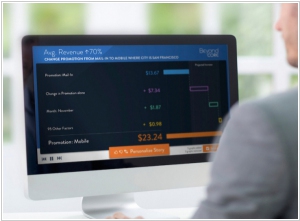
Salesforce has made an acquisition of the business analytics platform BeyondCore. BeyondCore is an enterprise analytics tool that enhances business intelligence through computational and statistical analysis. What sets BeyondCore apart is its existing integration with the Salesforce platform, which made it a favorable choice among various business intelligence companies that Salesforce could have considered acquiring. The true significance of this transaction, whether it will serve as a critical move in Salesforce's competition against Microsoft or simply a strategic acquihire, remains to be seen. For now, we eagerly await Salesforce's next acquisition while enjoying a bowl of popcorn.
2016. Salesforce Service Cloud added new field service product
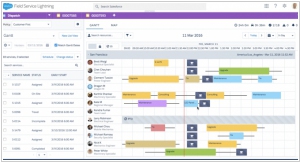
Until recently, Salesforce relied on third-party providers like ServiceMax for field service capabilities. Customer service calls were handled through Service Cloud, with a connection to the customer record enabling sales teams to be aware of any ongoing issues. However, there was no direct means to connect this information with field personnel, and Salesforce recognized the need to address this gap. To bridge the divide, Salesforce has introduced a new field service solution known as Field Service Lightning. This move is in response to the entry of key competitors such as Microsoft and Oracle into the field service market, highlighting the significance of this previously missing component for Salesforce. Please note that while the HTML tags and links were retained, they may not be properly rendered in this plain text format.
2016. SalesforceIQ integrates with Outlook
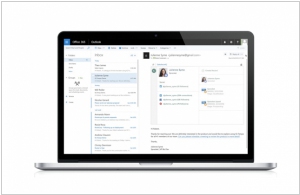
Salesforce has integrated its SalesforceIQ intelligence product with Microsoft Outlook, introducing an extension known as SalesforceIQ Inbox for Outlook. This integration facilitates a seamless connection between CRM, email, and customer social data, consolidating all this information within the inbox, where representatives typically operate. Notably, this integration eliminates the need for users to switch between applications or manually compile and establish connections between the data themselves. The SalesforceIQ Inbox for Outlook is now available for Outlook.com users at a cost of $25 per user per month. Integration with the Outlook desktop application is expected to arrive later this year.
2016. Salesforce released new Lightning CRM with SteelBrick integration
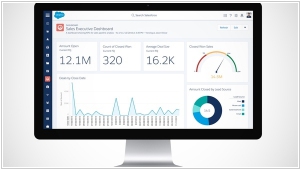
Salesforce has introduced an upgraded version of its Lightning CRM platform, incorporating several notable additions. The enhanced platform now includes integrated Wave analytics, intelligent email capabilities from its acquisition of RelateIQ, and configure-price-quote features obtained through the acquisition of SteelBrick in the previous year. Furthermore, Salesforce has introduced a built-in phone tool, enabling sales professionals to place calls directly from the Salesforce application. Although it may not possess the full capabilities of Skype for Business at present, this move suggests that Salesforce might be considering a future expansion into that market. To provide this functionality, Salesforce has integrated Twilio's Voice API into its application. With these new features, Salesforce aims to keep its customers within the Salesforce ecosystem, empowering them to manage customer relationships effectively. Users can leverage intelligent email integration to trigger automated actions, generate quotes, send contracts for signature, and even make phone calls without needing to leave the application.
2015. Desk.com integrates with Salesforce IQ
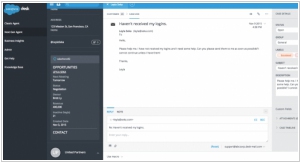
Salesforce has unveiled a consolidated offering that combines Salesforce IQ CRM and Desk.com customer service, catering specifically to small businesses. This integration empowers sales and service representatives to gain comprehensive insights into clients across various communication channels. Previously, such a holistic view was only accessible to larger enterprises utilizing expensive enterprise software, which was beyond the means of most small business owners. Consequently, this integration allows sales representatives operating in SalesforceIQ to access customer service notes and interactions, while customer service representatives in Desk.com can view the customer's purchase history.
2015. Salesforce released its next generation Service Cloud
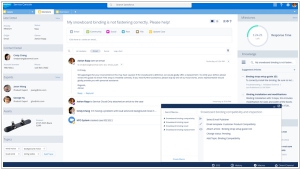
Salesforce is enhancing its Service Cloud, a platform designed for customer service agents and their managers. The company has introduced the new Service Cloud Lightning Console and a Service Wave Analytics App, aiming to enhance the overall job performance of customer service agents through improved experiences and analytics. These updates provide service teams with comprehensive and actionable insights, enabling agents and managers to optimize communication channels, enhance agent efficiency, and identify/address emerging trends. The enhancements encompass key performance indicators (KPIs) such as average handling time, customer satisfaction, and first call resolution, while seamlessly integrating with Service Cloud workflows and records. With the analytics dashboards offered by the Service Wave, service agents gain a comprehensive 360-degree view of the customer.
2015. Salesforce Marketing Cloud adds new connections to Sales, Service and display Ads
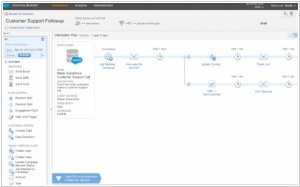
Salesforce.com has unveiled an enhanced version of its Marketing Cloud. This update introduces new functionalities to two key components: Journey Builder, a user-friendly tool for managing customer interactions, and Active Audiences, a feature that links customer data to online advertising campaigns. The Journey Builder now includes the addition of "Native Journeys," enabling seamless integration with the existing Sales Cloud and Service Cloud. Consequently, marketing teams gain expanded capabilities in designing journeys that span across marketing, sales, and customer service departments. Furthermore, Salesforce has introduced new pre-built triggers, such as joining a loyalty program or downloading an app, to initiate customer journeys. In addition to these advancements, Salesforce empowers advertisers to leverage their data more effectively by integrating Active Audiences targeting with various display ad networks.
2014. Salesforce connects to file-storage services. SharePoint Online is the first
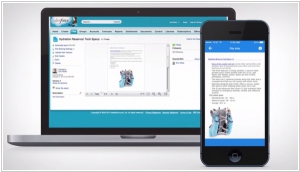
Salesforce has recently introduced Salesforce Files Connect, a newly launched centralized and universal file-sharing solution. This update allows users to access SharePoint Online, as well as SharePoint 2010 and 2013, with the addition of OneDrive for Business. While Salesforce has not provided a specific timeline for integrating with other file storage tools such as Dropbox and Box, it is likely that such integrations may be introduced in 2015. Notably, Google Drive has already been confirmed to be added in the upcoming months. Currently, the file sharing service for SharePoint Online and OneDrive for Business is offered free of charge for users of Salesforce Enterprise, Unlimited, and Performance editions. However, the service for SharePoint on-premises editions will be available at a cost of $7 per user per month.
2014. Salesforce enables enterprises to create their own App Stores
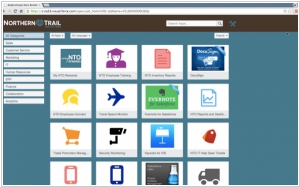
As the demand for mobile apps continues to grow, companies require an efficient solution to distribute and monitor their applications. Salesforce has introduced a new product called AppExchange Store Builder, which empowers companies to create their own personalized AppExchange. Salesforce has repackaged the software used to build the original AppExchange, a platform enabling Salesforce customers and partners to distribute their apps. The primary purpose of this tool is to provide customers with the means to launch their own internal app stores. They have the flexibility to populate the store with customized apps developed in-house or include commercial apps like Evernote or Salesforce.com. The customized AppExchange functions identically to the one available on the Salesforce.com website.
2014. Salesforce added app store to Desk.com
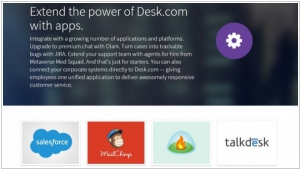
Salesforce has recently introduced significant updates to its customer service offering, Desk.com. Notably, they have unveiled the App Hub, an app store specifically curated for small and medium-sized businesses (SMBs). The App Hub serves as a convenient one-stop shop for SMBs to access various cloud applications essential for their operations. To enhance integration and streamline workflows, Salesforce has implemented a mechanism to directly integrate these partner apps into Desk.com. Among the notable partners featured in the App Hub are widely recognized products like Jira for issue tracking, MailChimp for email newsletter management, Olark for recording desktop chats, and, naturally, the core Salesforce.com CRM product. The update empowers users with centralized access to all these tools within Desk.com, leveraging the newly introduced 'Desk.com Canvas' to seamlessly install and incorporate these external packages into the Desk.com application.
2014. Salesforce unveiled Analytics Cloud
Salesforce.com has introduced its fifth cloud offering, known as Analytics Cloud, aimed at bridging the business intelligence gap within the Salesforce suite. This innovative solution presents a visually appealing graphical tool for accessing business analytics on both mobile devices and larger PC screens. Users can manipulate and analyze data by slicing and dicing it to create different perspectives, while establishing various connections between datasets. However, the platform still employs standard database language, such as "join," and utilizes database-style labels. It is important to note that some training or knowledge is still required to leverage Analytics Cloud effectively. The pricing for Analytics Cloud stands at $125 per user per month.
2014. Salesforce to add video support and new interface
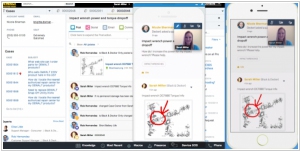
A week prior to Dreamforce, Salesforce made significant announcements regarding updates and new features. One of the noteworthy additions is the ability for companies to offer one-way video support to their customers. This feature enables customer service representatives to interact with customers through their screens without visually seeing them. Additionally, Salesforce is enhancing its CRM tool with a modernized interface and introducing new tools that go beyond sales monitoring. These tools cater to administrative tasks and provide step-by-step guidance throughout the sales process for those who require it. Among the new tools is "Today," a program resembling Google Now, which displays all your appointments, tasks, and relevant news related to your scheduled activities, including weather updates and more. Furthermore, a notes tool has been incorporated, allowing users to create checklists with a simple swipe of their finger. These updates and features aim to enhance the user experience and productivity within the Salesforce platform.
2014. Salesforce ExactTarget Marketing Cloud allows to build custom apps
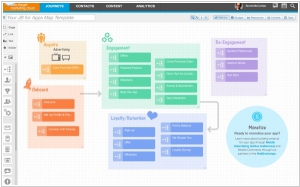
Journey Builder for Apps, the latest addition to ExactTarget Marketing Cloud, is now accessible to customers, featuring a range of valuable functionalities. This tool empowers users to create personalized customer journeys directly from mobile apps. Additionally, it enables customers to leverage the Salesforce CRM platform, facilitating the connection of customer journeys across sales, service, marketing, and communities. With Journey Builder for Apps, you can rapidly construct journeys using Journey Templates, seamlessly integrate apps into various customer interactions, incorporate locations and products into the journey, and effortlessly develop, expand, and deploy captivating and transformative apps. For those interested, the pricing for Journey Builder for Apps commences at $12,500 per year for a subscription license.
2014. Desk.com embeds video in customer support

Salesforce's Desk.com platform is embracing a visual strategy by introducing video support as part of its offerings. The CRM company has introduced the Salesforce Desk.com Support Center, which now includes the capability to provide video customer support. This exciting development allows companies to offer informative video content directly within their support center, enhancing the customer experience. Moreover, valuable analytics are provided to optimize customer interactions with the shared information. The next-generation video support is seamlessly integrated into the platform without any additional charges for Desk.com subscribers. Desk.com pricing begins at $30 per month, per agent, making it an accessible solution for businesses of various sizes.
2014. Desk.com adds mobile app, intelligent agent console
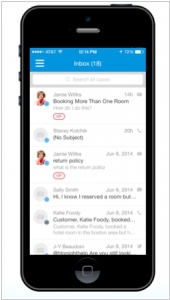
Salesforce has rolled out an update for its customer service application Desk.com, introducing several enhancements for automated customer service, including a new intelligent agent console, a mobile app, and a reporting engine. The intelligent agent console can be personalized on an individual basis to boost productivity, while maintaining brand integrity through rules, workflows, and templates. The updated reporting engine provides comprehensive real-time reports, metrics, and insights for managers. The mobile app enables users to add notes, update statuses, and assign cases. Additionally, Desk.com now offers 10 times more APIs, facilitating seamless integration with other applications to achieve a holistic view of the customer. The latest generation of Desk.com is now generally available, with pricing starting at $30 per month, per agent.
2014. Salesforce integrates with wearables

Salesforce envisions a future where wearables, such as smart glasses, bracelets, and watches, will revolutionize various aspects of business operations, spanning from office work to manufacturing. To support this vision, they have introduced Salesforce Wear, a collection of tools for developers to seamlessly integrate wearable applications with business applications on the Salesforce platform. For instance, they propose the creation of warehouse management apps for Google Glass, access control and time-tracking apps for Android Wear, and notification apps for Samsung Gear, among others. Moreover, fitness bracelets like Fitbit and Myo receive significant attention as Salesforce acknowledges the importance of addressing sedentary behavior in the workplace, considering it akin to the health risks of smoking. Consequently, they advocate for corporate-level management of employees' physical activity using fitness bracelets for companies that prioritize the well-being of their workforce.
2014. New friends: Satya Nadella and Marc Benioff
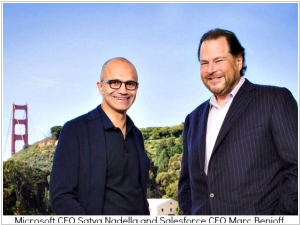
Until now, the relationship between Microsoft and Salesforce could hardly be described as friendly or collaborative. These two companies were fierce competitors in the CRM market and spared no effort to undermine each other's success. It's worth remembering that Microsoft even attempted to eliminate Salesforce by initiating patent lawsuits. The rivalry extended to marketing campaigns where both companies engaged in trolling one another. However, everything changed with the arrival of Satya Nadella as the new boss at Microsoft. Perhaps he recognized that the platform and office business held greater significance for Microsoft than CRM, and that establishing a partnership with Salesforce would yield more profitable outcomes than continuing to compete. Just recently, the companies made an exciting announcement about a strategic partnership. This collaboration entails the integration of Office 365 and Salesforce CRM, the development of a mobile platform for Windows Phone and Windows 8 to accommodate Salesforce, as well as the integration of their respective cloud platforms, Force.com and Microsoft Azure.
2014. Salesforce rocks: Radian6 Buddy Media Social Studio for ExactTarget Marketing Cloud
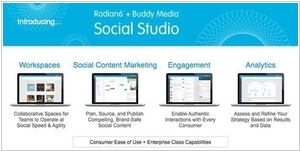
Salesforce has made a series of acquisitions in the marketing industry, and in order to maintain goodwill with these startups, they have chosen a rather inclusive name for their integrated product: "simply" Radian6 Buddy Media Social Studio for ExactTarget Marketing Cloud. This platform serves as a comprehensive solution for social content marketing, engagement, publishing, and analytics, while also providing collaborative features for marketers. Additionally, the Social Studio mobile app enables users to manage social marketing and engagement directly from their phones. Noteworthy features include workspaces designed for team collaboration, tools for planning and publishing social media content, customer interaction capabilities, and analytics for analyzing results. During its initial release, the Social Studio integrates seamlessly with popular stock photography services like Getty Images and Shutterstock, as well as content discovery tools including Kontera, Trendspottr, and Rallyverse.
2013. Salesforce 1 - really cool thing for your business
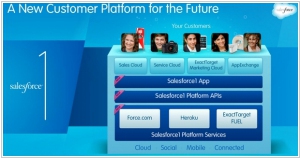
In former times Salesforce was the CRM company. It was developing and selling the CRM system. Then this business become boring for Salesforce boss Marc Benioff and he engaged into platform games with Force.com. And now it looks like Mark decided just to do show business. Look, yesterday the Dreamforce conference which is recognized as the coolest IT event of the year, started. A ticket to this show costs $1200 and it will be attended by 70 thousand people. Good business. But how to entertain Dreamforce visitors (and all those customers, paying for Salesforce CRM and platform)? They need something really cool. At this time - it's Salesforce 1. It's not clear what it is exactly, but looks very impressive. Judging by the pictures and video, Salesforce 1 - it is a platform, network (or Matrix, if you like), which connects everything: ***
2013. Salesforce launches Private AppExchange - the own App Store for your company
Usually Salesforce unveils a bunch of new products and news at the November Dreamforce event, but this year they decided to start beforehand. Over the last couple of weeks, they have already launched the single sign-on service Salesforce Identity, announced the death of Do.com and few days ago - released Private AppExchange - the private app store that any company can create for its employees. And, in this store company can "sell" employees not just mobile apps, but also web-based services and desktop apps. It can contain both privately-built applications and third-party products, taken from the public AppExchange. At first glance, it look like a useful thing only for IT administrator who can create a list of allowed applications, provide app access to certain employees, monitor their usage and pay for all licenses from single place. But it's also suitable for employees. For example, they can write app reviews, discuss app performance with their colleagues and troll the administrator if app doesn't work as it should. ***
2013. Salesforce buys marketing automation system ExactTarget for $2.5B
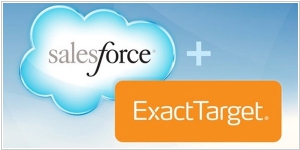
It's common knowledge that the CRM market is highly competitive, with virtually every vendor striving to develop their own CRM system. However, an interesting point to consider is the significant disparity between global spending on sales organizations (the primary function of CRM) and marketing expenditures. Marketing budgets tend to far outweigh sales budgets, prompting IT vendors to follow the money trail. As a result, a specialized market for marketing automation systems has emerged. Just how big is it? Well, consider this: Salesforce acquired one of the market leaders, ExactTarget, for a staggering $2.5 billion. This move was not an attempt to dominate the game, but rather an endeavor to catch up with industry giants like Oracle and Adobe, who already possess more advanced marketing systems. The key features of ExactTarget include email marketing, SMS marketing, landing page development, organizing offline events, and webinars. This seamlessly complements Salesforce Marketing Cloud, which provides comprehensive coverage for social media marketing.
2013. Salesforce Social.com - social ads management service
It turns out that a couple of years ago the Salesforce CEO, Marc Benioff, bought domain social.com (for $ 2 million). It's hard to imagine something more desirable for a man who loves beautiful domains and social technologies. And of course, for a long time he thought how to use put this domain, and finally he found the idea. He separated ad management part from the social publishing platform Buddy Media (acquired by Salesforce last year) and launched it as a separate service under the title Social.com. This service allow to optimize and run large-scale advertising campaigns on Facebook and Twitter, analyze their results and reduce the cost per lead. But probably the main news is not the launch of Social.com, but the integration of all marketing tools in Salesforce Marketing Cloud (Radian6, Buddy Media and Social.com). Watch the video: ***
2013. Video: Salesforce announces Customer Revolution
Last week, Salesforce unveiled their latest mobile app, Chatter, which has now become the primary mobile interface for employees, serving as a gateway not only to the social intranet but also to the CRM system. Furthermore, the enhanced mobile version of Chatter has transformed into a more convenient communication and collaboration channel between companies and customers. However, it wouldn't be in Salesforce's style to simply claim that the new app is "more convenient." Instead, they have crafted an entire narrative around a customer revolution that is already underway. According to Salesforce, your customers are mobile-savvy individuals who know how to leverage their phones effectively. They have the power to disrupt your business if they perceive your company as unresponsive to their problems and needs. This chilling video provides further insight. Take a look.
2013. Salesforce and Zoho launch support chat apps
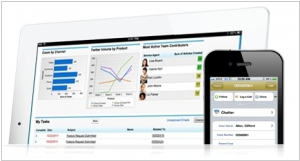
Yesterday Salesforce said: "Customers want to get support via their phones." Stop! This is how it was before. If something happened, you took your phone and called support. And then Salesforce said that people don't want to call, but want to get support online - on the provider site or in social networks. And now, we should call again? No. Salesforce means that now people want to get convenient online support, not only via computer, but also via their small phones. That is why yesterday Salesforce launched the new mobile app Service Cloud Mobile, which includes mobile chat, mobile knowledge base interface, and even mobile browsing (co-browsing). And all these features can be embedded directly into your mobile app, providing maximum convenience for customers. The chat service costs $50/month for 1 operator. ***
2013. Salesforce turns Do.com into platform. Launches paid version
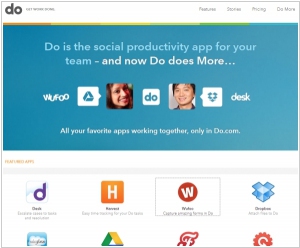
Naturally, Salesforce had limited interest in providing a free task and project management tool like Do.com. As a result, they began by incorporating CRM functionality into it, subsequently launching a paid version that included CRM and access rights management. Now, Salesforce aims to transform Do.com into the focal point of enterprise IT infrastructure. They assert that employees in every company are consistently engaged in task resolution, necessitating a task-centered IT infrastructure (and consequently, a Do.com-centric one). To achieve this objective, Salesforce has developed an ecosystem known as Do More, which encompasses third-party services integrated with Do.com. Notably, this ecosystem incorporates services such as Dropbox, Google Drive, form editor WuFoo, time tracker Harvest, Salesforce's helpdesk service Desk.com, and others. Consequently, users can now attach files from Dropbox to their tasks or track task durations using Harvest. It is worth mentioning that Salesforce already possesses another collaboration service, Chatter, which is positioned as a corporate social network akin to Facebook. It is intriguing to consider whether the company plans to integrate these two collaboration systems or approaches.
2012. Video: The Future of Business - Salesforce Edition
During the Dreamforce keynote, Marc Benioff subtly suggested that following Steve Jobs' passing, he has become the foremost visionary in the tech industry. While Marc expressed the notion that "we should now carry on his endeavors," the implication is evident. This perception is further reinforced by a video presentation. The video reveals that Salesforce's mission no longer revolves around developing innovative applications or creating the world's premier enterprise platforms. Instead, Salesforce's mission is to demonstrate to companies what the future of business will resemble and guide them into that future. How does Benioff envision the future of business? Unsurprisingly, it revolves around being social, mobile, and cloud-based. Additionally, the new aspect involves imbuing all inanimate objects such as cars, houses, and machines with social capabilities, enabling communication with people via Chatter. The video is highly recommended for viewing, preferably in a cinema-like setting.
2012. Top 7 Dreamforce stories
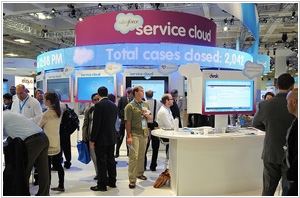
At the Dreamforce 12 conference Salesforce presented a lot of new products, but the problem is that most of these new products either had been already presented at the conference last year, or will become live to next year's conference. So, we'll just briefly go over the main ones: ***
2012. Work.com - work becomes more interesting
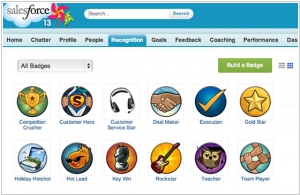
The highly anticipated Dreamforce event has commenced, and we are now delving into the latest Salesforce product offerings. Firstly, the team at Box.net can breathe a sigh of relief, as it appears that ChatterBox is still in the midst of development and won't be released until sometime next year. However, another service, Work.com, is already up and running. Work.com is essentially a rebranded version of Rypple, a company that Salesforce acquired last year. It's Rypple, but with a sleek new domain. We have previously provided a comprehensive review of Rypple, which is a solution for gamifying human resource management and achieving business goals. Here's how it works: Executives establish goals for each team member, monitor their progress, and provide reviews and rewards such as "thank yous," badges, and gifts (e.g., Amazon gift certificates). As a result, a) employees have clear objectives, b) employees are engaged in an intriguing work-game, and c) the company achieves its goals, as employees' objectives align with those of the business. In addition to its appealing domain name, Salesforce has integrated Chatter into the service, allowing for the tracking and discussion of employee achievements within the enterprise social network.
2012. Mark Benioff about Salesforce's new services, Google, Yammer and ropejumping
Michael Arrington interviewed the Salesforce CEO, Marc Benioff, at the TechCrunch Disrupt conference. Here is the list of 10 most interesting quotes and news: ***
2012. Salesforce adds social CRM features to Do.com
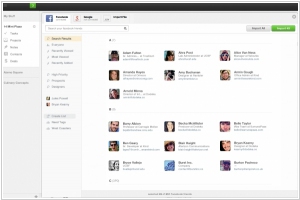
Do.com - is a simple (and free) service for managing tasks and projects that Salesforce has created on the basis of the purchased Manymoon last year. And because all Salesforce applications should become more social and customer-oriented, the first update of Do.com is following this direction. Actually it's quite reasonable because almost all tasks that arise in any company or related either to projects, or to customers. Projects are already present in Do.com. Now it add the Contacts module. You can pull contacts from your account on Facebook or Google+ (or simply import contacts from CSV file). Contacts can be sorted using tags and linked with tasks. ***
2012. Salesforce acquires social marketing champion Buddy Media
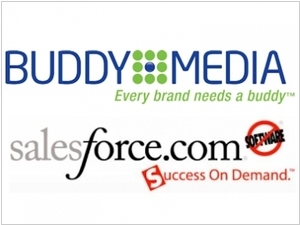
Perhaps, some years ago SAP and Oracle thought on the opportunity to acquire Salesforce, but for some reason decided that it was bad idea. And now Salesforce itself can make big purchases, even bigger than these dinosaurs. Today, Salesforce announced the acquisition (for $689 million) of Buddy Media - the largest social marketing service. Last month Oracle bought a similar (but not so popular) service Vitrue (for $300 million). From the one hand with Buddy Media Salesforce is buying the client base, as Buddy Media has more than 1,000 large customers, including Virgin Mobile, HP, Matte and L'Oreal. In addition, the service is used by 8 of 10 world's largest advertising agencies. On the other hand Buddy Media - is a great addition to another social marketing tool - Radian6, that Salesforce bought last year. Radian6 is used for listening social networks while Buddy Media is a tool for publishing content to social networks and measuring the effectiveness of social marketing campaigns. ***
2012. John Wookey tells why Oracle and SAP can't catch up with Salesforce
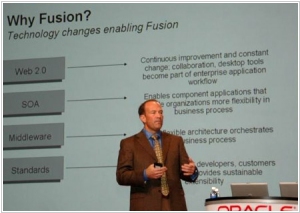
The cloud race Oracle vs SAP goes on. Oracle has bought (for $300 million) one more SaaS-provider - Vitrue, which provides the social networks monitoring service. In the meantime, this show (Oracle vs SAP) now has an interesting commentator - John Wookey. This guy once worked as vice-president for Oracle and led the development of SaaS-package Fusion. But at that time Larry Ellison thought that "Cloud is just water vapour", so John didn't bring this development to the end and left Oracle to SAP. In SAP, he was in charge of building the SaaS ERP system Business ByDesign. At this time, John managed to launch the system to commercial phase, but this project also appeared to be unsuccessful. Now John Wookey works ... in Salesforce as a vice president for social applications and explains why (despite the record SaaS acquisitions) Oracle and SAP can't compete with Salesforce. ***
2012. Salesforce launched Site.com - (strange) service for site-building
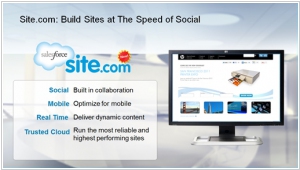
Hooray! Marc Benioff bought another cool (and probably very expensive) domain Site.com. Actually, that's all news, because the service for simple site-building launched on this domain - is not new. It's all the same Siteforce tool, previously available in Salesforce's marketing cloud. And, in our opinion, this service is not worth of such domain. We still believe that there is a great demand for simple site-building service. But what Salesforce offers - is nonsense. Of course, the visual editor in Site.com - is very powerful. It's so CSS-oriented and allows to create pages from templates, forms, dynamic pages, pull content from a database, use JavaScript and even publish pages to Facebook. But it's not simple. Rather, it's more suitable for web designer, than for marketer. And why web designer needs this toy, if he can faster create a better site in a code editor? ***
2012. Salesforce launched Helpdesk-app for small business Desk.com
Salesforce keeps us happy with its new habit not to dissolve acquired startups in its core (large and expensive) CRM system but to use them for building simple and useful apps for small business. Last autumn Salesforce for $80 million acquired SaaS-Helpdesk service Assistly, made a face-lift, added mobile HTML5-client (for iPhone, iPad, Android), bought a cool domain - Desk.com and here is the new service! Desk.com allows you to organize client support by email, phone, via the customer portal on your the website, as well as in social networks. Any message in Facebook and Twitter can be converted into a ticket, assigned to support agent, processed in the support workflow and responded directly to the social network. And then you can publish it to the customer portal in order to reduce the number of same questions coming to support. ***
2011. Talent Management and Gamification on the rise: Salesforce buys Rypple
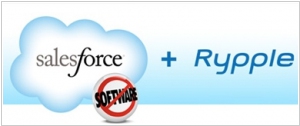
Salesforce - is if not the trend-setter in the Enterprise, than it's certainly the indicator of most important trends in this sphere. The company had grown on the wave of CRM and SaaS, then came to the front edge of cloud platforms, mobile applications and social software. And now Salesforce wants to occupy two more hot areas - Talent Management and Gamification. The common goal of these technologies - is staff motivation and development. Crazy demand for talent management system has been proven by SuccessFactors, which has set several records in SaaS-implementation and recently was acquired by SAP. And we have already mentioned about Gamification potential. So, today Salesoforce has bought one of the most promising startups in these areas - Rypple (known as Zynga for Enterprise). ***
2011. Salesforce launched Marketing Clouds
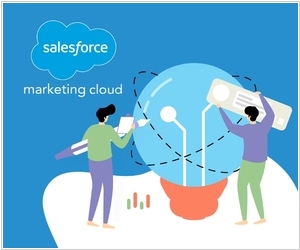
Salesforce always used to call its products - the Clouds. Until now, Salesforce had 3 product-clouds: Sales Cloud (CRM system), Service Cloud (customer support system) and the Collaboration Cloud (or Chatter). Today the company is launching the new Social Marketing Cloud. It's a combination of two products: the social media monitor Radian6 and cloud CMS for creating websites Siteforce. We have already told a lot about Radian6. Radian6 was acquired by Saleforce earlier this year and it's customer list includes Dell, GE, Kodak, UPS, etc. Radian6 can monitor social networks for mentioning of your brand, company, products, competitors, analyze public opinion, engage in to social conversations. Integration with Salesforce CRM now allows to use Radian6 to create social profiles in CRM and track the history of social communications, send messages to social networks directly from the CRM interface. ***
2011. #OccupyTheEnterprise vs KLM Surprise: what will you choose?
Salesforce CEO Marc Benioff can use any news or events for his marketing purposes. In his latest speeches, Mark is talking about the well-known social movement Occupy Wall Street. As you know, this demonstration was organized mainly via the social networks, and in particular thank to the Twitter hashtag #OccupyWallStreet. "Look, what social networks can do" - says Benioff - "they can overthrow governments. And they also can easily destroy your business. Ignoring social networks - is ignoring your customers." Benioff has launched his own Twitter hashtag #OccupyTheEnterprise and scares enterprises with it. And from the other hand, he cites the example of using social networks by the Salesforce client - KLM airlines. ***
2011. Salesforce created task and project management service Do.com
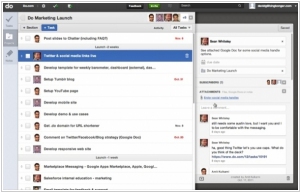
Remember, earlier this year Salesforce acquired the best project management service for Google Apps - Manymoon? Today the result of this acquisition has appeared - task and project management app Do.com. The app is very simple and straightforward: you can create projects, invite co-workers or customers, create tasks (to-dos), assign owners. To each project you can attach files and add comments. Tasks can be created via email, comments can be added via email and you receive notification to your email. iOS mobile application is already available, Android app is coming soon. Meanwhile the registration is by invitation only, but when Do.com opens later in November - it will be free. Paid (additional) features may appear in the next year. And the main question is: why Salesforce needs such a tool? ***
2011. Salesforce acquired social Helpdesk service Assistly
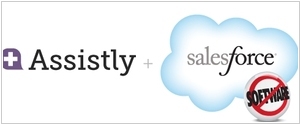
Salesforce has made a serious commitment to becoming the leading provider of customer support solutions. Their own offering, Salesforce Service Cloud, is already soaring to great heights, but its price may be too high for small businesses. To cater to the needs of SMBs, the company has decided to acquire one of the two most popular SaaS Helpdesk services, Assistly (the other being Zendesk), for a whopping $80 million. Assistly seamlessly aligns with Salesforce's innovative Social Enterprise concept. This service enables communication with customers via Twitter, Facebook, client forums, live chat, as well as traditional channels such as email and phone. Support agents can conveniently work within a unified interface. Additionally, Assistly is renowned for its unique pricing structure: it offers free usage for one helpdesk agent, with additional agents billed on a per-hour basis ($1/hour). Hence, if no support requests are received, your company incurs no cost for the helpdesk service.
2011. Nitro for Salesforce - gamified CRM
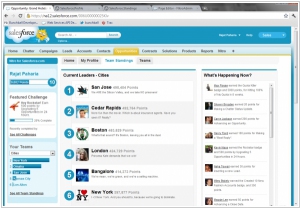
We continue to monitor the gamification of business applications. And the first gamified CRM is ... Nitro for Salesforce. This system was presented at the recent Dreamforce 2011 conference and will launch later this month. It's interesting that Nitro for Salesforce is created not by some guys from garage, but by the gamification professionals at Bunchball. For several years, this company is developing games for various projects. Its clients include Warner Brothers, NBC, HP, Comcast, Playboy. However, so far the company developed game mechanics only for consumer projects, and now decided to try its technologies in business application. As it's clear from the title, Nitro for Salesforce - is an add-on for Salesforce CRM. ***
2011. Benioff: goodbye Cloud, hello Social
On Friday nobody wants to read long news. Good video is much better. This is the video that was shown at the opening of the Dreamforce 2011 conference - probably the most glamorous event in the IT-industry. This video marks the focus change of Marc Benioff and his Salesforce. Last eight years the Dreamforce conference started and ended with the word Cloud. Now it changed. Moreover, one of the main news of this year conference was the opportunity for Salesforce customers to store part of their data on a local server, not in the Cloud. And the new main focus for Salesforce is Social Enterprise. Benioff is comparing modern companies with the Arab countries falling under revolutions: "Either CEOs will make their companies social, or customers and employees will depose them like Muammar Gaddafi". So what should a company do to become social? ***
2011. Salesforce. The Movie
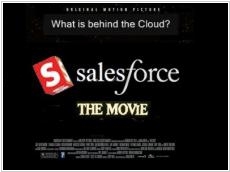
Columbia Pictures film makers are said to be keen to follow-up the phenomenal box office success of The Social Network with the new IT blockbuster. And they see the meteoric rise of the Cloud giant Salesforce.com as the perfect story. In addition the screenplay is almost ready - it will be base on Marc Benioff's book "Behind the Cloud". The new movie, that will be called "Salesforce. The Movie" - is the story of how a simple idea grew out into the billion-dollar business, of how young Benioff did not give up when the leaders of the software industry, led by his former boss Oracle CEO Larry Ellison, laughed at him. At the moment Columbia Pictures has already commissioned a screenplay and is casting for the major roles. Russell Crowe is strongly tipped to land the lead role of CEO Marc Benioff: ***
2011. Salesforce acquires the best Social Web monitor - Radian6
The integration of Social Web monitoring into modern CRM systems is increasingly crucial, and Salesforce is determined to stay at the forefront of this emerging trend. In a recent announcement, the company revealed its acquisition of the esteemed Canadian service, Radian6, renowned for its exceptional capabilities in social Web monitoring. Notably, Radian6 boasts an impressive client roster including Dell, General Electric, Kodak, Pepsico, UPS, and Microsoft. Furthermore, Radian6 serves as a built-in tool within other CRM systems and social software solutions like Jive and HubSpot. Recently, Radian6 was also successfully integrated with Salesforce Service Cloud, which likely played a pivotal role in Salesforce's decision to acquire the company. According to Mark Benioff, the CEO of Salesforce, they plan to leverage Radian6 not only for Sales Cloud and Chatter to unite internal and external communities but also for the Force.com platform, enabling effortless integration of third-party applications with various social networks.
2011. Salesforce Service Cloud 3 allows to help customers via live chat, Facebook, Twitter and Facetime
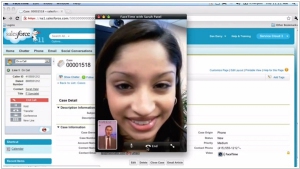
The guys from Salesforce, that are engaged in developing Service Cloud, can't help repeating that traditional customer support systems (Call-centers + CRM / Helpdesk) - are already obsolete. They are built in expectation that a phone call is the primary communication channel that customers use to get support. But the world has changed. Customers want to solve their problems via the Internet - in Facebook, Twitter, forums. They want to talk to tech support via online chat or personal account at the company's website. They want to read what other users say about a product. They want to use video and screen-sharing, to show the problem to support engineer, rather than explain everything by phone. All these requirements are met in the new version of Service Cloud 3. ***
2011. Salesforce acquired web-conferencing service DimDim
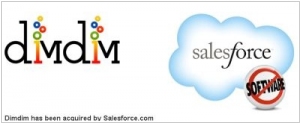
Salesforce has recently made a significant acquisition, purchasing the Indian web-conferencing service DimDim for $31 million. This acquisition is highly suitable for Salesforce as the company aims to establish dominance in the collaboration market with its social collaboration system, Chatter. Web-conferencing and video conferencing, which DimDim provides, are essential components of effective collaboration. Furthermore, DimDim can serve as a solution for online presentations and remote support, seamlessly integrated into Salesforce's Sales Cloud and Service Cloud. The only aspect that may seem incompatible is the difference in business approaches between these two companies. DimDim is well-known for its freemium open-source model, which has been a source of frustration for key market players such as Webex, GoToMeeting, and Adobe Connect. On the other hand, Salesforce tends to prioritize revenue generation and provides free offerings only after careful consideration of profitability. As a result, it is not surprising that shortly after the acquisition announcement, the free SaaS and open-source versions of DimDim were removed from the website. Users who were already utilizing the free SaaS version can continue to do so until March 15, 2011. The open-source version of DimDim can still be accessed on Sourceforge.
2010. Salesforce acquired Email/CRM startup
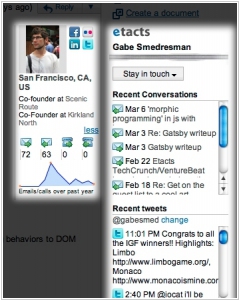
Social Email plug-ins have become a hot topic. And as a result - the increasing interest towards them from the large vendors and investors. The most well-known representative of this class - Xobni was actually acquired by Cisco. Rapportive recently received the $1 million investment. The other day it found out that RIM (Blackberry) is going to acquire Gist. And yesterday, Salesforce bought for $6 million another similar service - Etacts. As all above mentioned tools, Etacts can pull contact profile data from public social networks and display it in email-client - so it acts as a the social CRM. But besides that, it lets you send personalized email-campaigns, display the history of communications with certain person and remind you when you need to contact him. How does it do it? ***
2010. Force.com 2 - already 5 PaaS platfroms
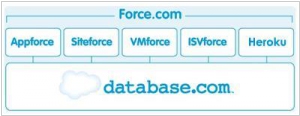
At the Dreamforce conference, Salesforce demonstrated one more time that now it's not so interested in CRM (it was mainly a subject for jokes) as in cloud platforms. Following the release of SaaS database Database.com, the company introduced another big Force.com feature - Heroku - the PaaS startup that Salesforce has recently acquired for $ 212 million. Heroku - is a cloud platform for developing and hosting Ruby-applications (Ruby - is a popular framework for developing Web apps, created by 37Signals). Heroku became one of the five PaaS-services included in the new version Force.com 2. And the new structure of the Force.com platform now looks like this: ***
2010. Benioff gives a marketing master class to Microsoft

Microsoft marketing people couldn't get enough of their cool marketing idea. On the street near the conference center, where the Salesforce's Dreamforce conference takes place, they send their people on segways with banners (on picture). The banner shows a dissapointed man, who has moved from Saleforce to MS Dynamics CRM Online. Under his photo there is a strapline: "I didn't get forced". But Microsoft marketers did not know whom they are dealing with... In the beginning of the second coference day Mark Benioff, Salesforce CEO, entered the stage... ***
2010. Salesforce unveiled SaaS database - Database.com
It seems that Marc Benioff, Salesforce CEO, was thinking for a long time about how to outdo his "friend" Larry Ellison and prove to him that Cloud Computing - is not a vaporware. And he invented a cloud database that will run as a SaaS service without any software and hardware. After all, Oracle is now virtually a monopolist in the database market (after the SUN/MySQL acquisition) and if it will work, it's the best way to hurt Larry. For greater effect, Benioff has bought an ideal domain Database.com. And today at Dreamforce conference Mark presented the new service. Database.com allows to create reliable, scalable databases using the visual interface and access them from any mobile / web / desktop application via API-interfaces (SOAP and REST). It allows to store any type of content (including documents, pictures, video), supports the SQL query language and provides many additional bells and whistles, like push-update data from the database to application, user management and user authentication. ***
2010. Microsoft sues Salesforce.com. SaaS industry in danger
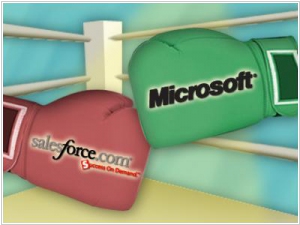
This week, Microsoft filed a lawsuit against Salesforce, blaming the SaaS company in violating 9 patents. These patents are not about CRM functionality (it would be strange, because Salesforce CRM appeared earlier than Microsoft CRM was developed), but about basic software technologies. For example, here is the technology of displaying web-page with embedded menu: "A request for a web page is received from a web browser In response to the request, a web page and an applet associated with the web page are packaged for transmission to the web browser. The web page and the applet are then transmitted to and downloaded by the web browser. When the web page is displayed and the applet is executed by the web browser, the applet creates and manages an embedded menu in the displayed web page under control of the applet . This embedded menu provides a user of the web browser with a plurality of links through one action in the displayed web page." Perhaps having this patent, Microsoft could close any SaaS vendor, but they have chosen Salesforce, their main competitor on CRM market. ***
2010. Salesforce goes into amoral crowdsourcing
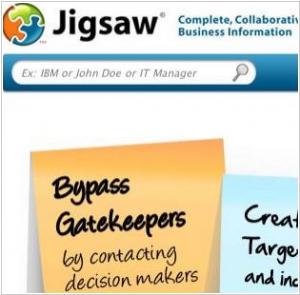
Nowadays the confidentiality of personal information is not so important. Especially for sales guys, like Salesforce's management. Today, Salesforce has acquired Jigsaw, which TechCrunch's Mike Arrington at first called evil and then simply amoral. Jigsaw - is a huge (21 million) online database of contacts and companies, filled by crowdsourcing: users add contact information of other people (without their knowledge) usually from business cards. When the service appeared in 2006, it paid people $1 for each added contact. Then Jigsaw sell the access to contacts database to companies using cold calling (or spammers). And there was no way to remove your contacts from the service. ***
2010. Salesforce now can automate business processes
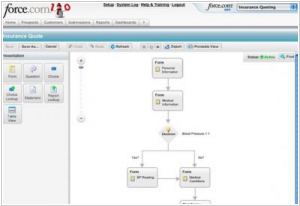
Yes, Salesforce still had no inbuilt business processes automation tool (only integrated third-party solutions). But business process automation - is a delicate feature that it's better not to provide it at all than provide it somehow. Many other CRM systems promote their business-process automation modules, but actually they bring more problems than profits. In contrast, the new Salesforce module - Visual Process Manager looks pretty nice and simple. Generally, in this case it is better not talk about business processes, but about automation of any operation in the system. There are 4 main spheres where this new tool could be applied: ***
2009. Salesforce acquired SaaS collaboration service
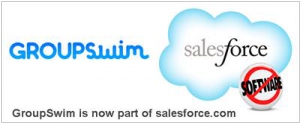
It appears that competing with MS Dynamics CRM is not sufficient for Salesforce. The company now aims to establish itself as a comprehensive SaaS alternative to MS Sharepoint. Salesforce already offers the Force.com platform for developers and only lacks the intranet functionality. To address this gap, Salesforce has recently acquired the SaaS collaboration service GroupSwim. GroupSwim is a popular startup that enables the creation of workgroups (sites) with features such as wikis, file storage, and forum discussions. It utilizes semantic technology to automatically tag and rate various types of content, including discussions, emails, documents, and wikis. Up until now, Salesforce primarily relied on integration with Google Apps as its main collaboration solution. Additionally, Box.net recently unveiled a file-sharing solution for Salesforce CRM. However, it seems that Salesforce, having recently introduced the social layer Chatter, is now intending to develop its own collaborative layer.
2009. Adobe and Salesforce unite against Microsoft
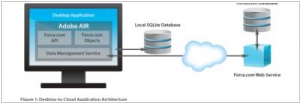
Salesforce and Adobe announced about their strategical partnership, that supposes integration of their platforms Force.com and Adobe Flash+AIR. For Salesforce it means a huge step forward towards rich internet applications and desktop integration. So now they can enhance these two features in competition against Microsoft S+S applications like Microsoft Online Services. And for Adobe - this is an attempt to enter the enterprise market and to strengthen its position against Microsoft Silverlight attack. The first joint product of the new alliance is Adobe Flash Builder for Force.com - integrated development environment that allows to create flash-plugins for Salesforce CRM or stand-alone flash-applications, working on top of Force.com platform. ***
2009. Cisco and Dell to sell Salesforce CRM
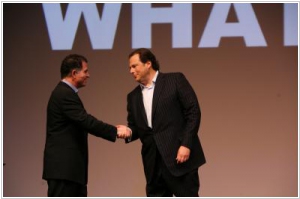
Undoubtedly, Mark Benioff possesses the ability to persuade anyone to purchase Salesforce CRM. However, if the product were subpar, partnerships would come to a halt. Yet, that is not the case. It appears that Salesforce's major customers, Cisco and Dell, are incredibly loyal to the platform and have even begun reselling Salesforce themselves. Just last week, Cisco and Salesforce announced a collaborative solution for customer service, combining Salesforce Service Cloud 2 with Cisco Unified Communications. Today, Dell and Salesforce have revealed a new offering that integrates Salesforce CRM with Dell Integration Services. Both solutions are geared towards the small business market. Considering the extensive customer bases of Cisco and Dell, it is highly likely that Salesforce will achieve new income records in the coming years.
2009. Salesforce announced Service Cloud 2.0

Service Cloud - is the revolutionary customer service solution, that integrates helpdesk with social networks and tools. Today Salesforce unveils the second generation of Service Cloud with 3 new modules: Salesforce Knowledge, Salesforce Answers and Salesforce for Twitter. All them are tightly integrated with Salesforce CRM and built on top of Force.com (so they can be customized for particular company needs). Starbucks, Comcast and Dell are already using these new tools. ***
2009. Salesforce launched Sites and free Force.com
Salesforce has introduced a new capability called Force.com Sites, enabling companies to develop and operate their online applications on the Salesforce.com cloud computing platform for both internal and public use. This feature allows companies to build databases with customized privacy settings, create public sites using various programming languages such as HTML, JavaScript, Flex, and CSS, access analytics, register domains, and more. The introduction of Force.com Sites reflects Salesforce's aim to expand its cloud offering, enabling hybrid applications that cater to both internal enterprise customers and external users. Additionally, Salesforce has announced a free edition of Force.com, providing small businesses and entrepreneurs with a cost-effective way to utilize Salesforce's platform.
2009. Salesforce.com adds Twitter to Service Cloud
Salesforce.com, the provider of the Service Cloud, a customer service application that leverages crowdsourcing, has now integrated Twitter into its platform. This integration enables customer service representatives using the Software-as-a-Service (SaaS) to access tweets from a vast user base of more than 8 million Twitter users. The Service Cloud allows enterprises to search for and monitor tweets related to their companies, products, and brands. By capturing and tracking these conversations within the Service Cloud, a comprehensive database is created for ongoing monitoring. In addition to Twitter integration, the Service Cloud also facilitates connectivity to online communities, social networks, and the blogosphere, offers SEO tools, shares knowledge with business partners, and seamlessly integrates customer service operations into the cloud. This move by Salesforce.com acknowledges the significance of Twitter as a platform for important conversations and aims to provide this valuable information to its users. It also reflects the media's fascination with Twitter, which Salesforce.com saw as an opportunity to gain attention. While Salesforce.com presents this as a customer service tool, it is equally applicable to sales, as it allows users to gather insights before engaging in important conversations or calls by checking what is being said about individuals, firms, or relevant topics. This integration with Twitter is a significant development, as it makes these conversations readily available on a widely-used platform.
2009. Salesforce - the first SaaS vendor to hit $1 billion in annual revenues
Salesforce reported its financial results for the fourth quarter and full year, with annual revenues reaching $1.077 billion and net income of $43.4 million ($0.36 a share). The company concluded the year with 55,400 corporate customers and 1.5 million individual subscribers. Looking ahead, Salesforce anticipates a revenue growth of approximately 30 percent in the upcoming fiscal year, projecting it to reach $1.3 billion. Achieving the $1 billion milestone marks a significant achievement for both Salesforce and the cloud computing industry as a whole. Notably, Salesforce is the first enterprise cloud computing company to attain such a size exclusively through the sales of web applications.
2009. Salesforce.com Launches The Service Cloud, A Customer Service SaaS Application
In today's digital age, when faced with a technical query, many people turn to Google rather than customer service for answers. Salesforce.com has recognized this trend and recently launched a customer service application called Service Cloud. This innovative application, based on a Software-as-a-Service (SaaS) model, aims to tap into the vast pools of knowledge available on the internet and utilize them for commercial customer support. Traditional contact center technology, which is typically on-premise, remains disconnected from the wealth of expertise and information found in the cloud. However, numerous customer service questions are already being addressed online through forums, social media platforms like Facebook, search engines like Google, e-commerce platforms like Amazon, and even within personal communication channels such as instant messaging, email, and corporate intranets. The Service Cloud integrates with these various environments through plugins, allowing companies to manage and participate in service conversations happening in the cloud. Salesforce.com's chairman and CEO, Marc Benioff, explains that this is made possible by leveraging the power of native cloud computing platforms like Force.com, which can harness the capabilities of other clouds such as Facebook, Google, and Amazon.com. The Service Cloud comprises several key components, including online communities for interacting with both the company and other customers, connections to existing social networks and the blogosphere to channel existing knowledge into the company's knowledge base, search engine optimization (SEO) features to ensure the company's community appears prominently in search results, the ability to share knowledge with business partners easily, and contact center technology that grants customer service agents access to the knowledge base. While the concept of capturing and systematizing knowledge from friends and online sources seems promising and could potentially save costs on call centers, it's important to note that customer service is a complex issue that goes beyond the technical realm. Although capturing knowledge from the cloud sounds appealing in theory and can be easily aggregated through technologies like RSS and APIs, effectively organizing and swiftly retrieving specific solutions for individual problems is a more challenging task. Nonetheless, for enterprises seeking to revamp their customer service systems, adopting cloud-based solutions like the Service Cloud makes sense, as it offers advantages such as improved search engine visibility and potentially enhanced customer support capabilities.
2008. Zoho to Salesforce: Let us onto Force.com
After the election, Barack Obama and John McCain are expected to move on, but the CEOs of Zoho and Salesforce.com may not be ready to bury the hatchet just yet. Sridhar Vembu, CEO of AdventNet, the parent company of Zoho, has publicly accused Salesforce of trying to prevent customers from migrating to Zoho CRM. Earlier this year, Vembu shared details of negotiations with Salesforce to integrate Zoho with AppExchange, but the joint development was halted before the product launch. Vembu claims that Benioff repeatedly attempted to acquire Zoho, but they rejected the offer due to the lack of cultural fit and incompatible business models. According to Vembu, Salesforce has since tried to block customer migrations to Zoho CRM by falsely claiming data restrictions until contract durations are over. Vembu asserts that Salesforce's actions contradict their claims of platform openness. Salesforce has yet to comment on the matter.
2008. Salesforce.com’s Clouded Dreams
Perhaps Larry Ellison was correct in his assessment that cloud computing has been excessively hyped, to the point where the term is now used to describe almost anything. A prime example of this is Salesforce.com's Dreamforce event, where co-founder and CEO Marc Benioff has embraced the cloud computing buzz. Despite the marketing theatrics, it's undeniable that Benioff has created a movement with Salesforce.com's software and platform. The Expo hall at Dreamforce showcased numerous companies developing applications on Salesforce's Force.com platform, hinting at its potential as an enterprise-focused solution. By leveraging its extensive subscriber base and partnerships with Amazon Web Services, Facebook, and Google, Salesforce.com is positioning itself as a specialized cloud platform. This approach allows web applications to tap into different services for hosting, subscriber management, authentication, and data sources, creating a comprehensive cloud stack. While the hype surrounding cloud computing may be excessive, Salesforce.com's strategic direction appears to be on the right track.
2008. Salesbook and Faceforce Doing the Samba
The combination of Salesforce and Facebook seems to have a certain appeal, and while I've had my doubts about Facebook's practicality, its vast user base of 120 million people generates its own value through sheer momentum. That's why I found it intriguing when Facebook's COO, Sheryl Sandberg, announced at Dreamforce that Salesforce and Facebook are teaming up to enable force.com applications to leverage Facebook's social graph. A video demonstration showcases Salesforce's ideas application, which enables companies like Dell and Starbucks to harness the collective wisdom of the crowd to generate ideas for potential products or services. This collaboration is a smart move for both companies - it empowers Salesforce to offer its customers the true power of virality, while allowing Facebook to tap into the lucrative business market.
2008. Salesforce wants to be a force in knowledge management too…
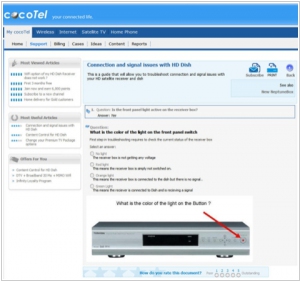
Salesforce initially established itself in the customer relationship management (CRM) space, offering a solution to streamline sales processes within companies. However, knowledge management encompasses more than just sales processes, making Salesforce's recent acquisition of InStranet a logical move. InStranet provides a powerful tool called Dimensions, which has immense potential in effectively managing the ever-increasing volume of information present in businesses. Dimensions serves as a solution to organize and categorize a company's knowledge base. When a customer seeks specific information, InStranet's Dimensions can efficiently sift through vast amounts of irrelevant data and present only the relevant information. This capability enables businesses to accumulate extensive amounts of data, with the assurance that the information remains easily accessible when needed.
2008. Google, Salesforce link up for business apps
Salesforce.com and Google have officially announced their partnership, offering integrated Google Apps with Salesforce's CRM applications. Customers of Salesforce.com can now utilize tightly linked versions of Google Apps, including Gmail, Calendar, and Google Talk, which are seamlessly integrated with Salesforce.com. This integration allows customer interactions, such as email responses and Google Talk conversations, to be appended and accessed from a single place within Salesforce.com. While Salesforce.com has previously integrated with Microsoft's Office and Outlook desktop applications, this marks their first venture into providing a comprehensive web-based application package, breaking away from desktop applications. The decision to integrate with Google Apps was driven by customer requests through Salesforce.com's Idea Exchange forum. Salesforce.com remains open to collaboration with other office applications and partners. The integration with Google Apps will be offered at no additional charge to existing customers, while a paid service called Salesforce for Google Apps Supported will provide telephone support, unified billing, and additional APIs for a fee.
2007. Salesforce Facilitates Data Exchange Between Tenants
Salesforce is set to launch a new service called Salesforce to Salesforce (S2S) tomorrow, aimed at enabling data sharing between companies using Salesforce's software as a service (SaaS). While businesses have been able to manage their organizational data with Salesforce applications provided by AppExchange or built on Force.com, the data has been largely isolated from other companies using Salesforce's hosted software. With S2S, companies can now share data with partner organizations, leveraging Salesforce's multi-tenancy architecture. Modeled after the sharing functionality of social networks like Facebook, S2S allows users to search for contacts, establish connections, and share data objects such as leads or plans. The cost for data transfer between two companies is $100 per month, borne by the company that sets up the connection. Salesforce expects to reach one million subscribers by the end of this month, with over 38,000 companies already utilizing their services.
2007. Salesforce.com extends its application platform with Force.com
Salesforce.com is set to unveil an expansion to its web-based developer platform at the upcoming Dreamforce developer conference in San Francisco. The company will introduce Force.com, a collection of tools and hosted services for building web applications, positioning itself as a competitor to traditional offline development tools. Additionally, they will present Visualforce, a service that enables developers to create customized application user interfaces. Attendees of the conference will have access to a developer preview of Visualforce. This introduction of a user interface service is significant as it enhances Salesforce.com's hosted development platform, making it a more viable option for IT managers and chief information officers seeking alternatives to Java or .Net. According to Adam Gross, Vice President of Developer Marketing at Salesforce.com, the user interface layer expands the reach of their applications to new users and devices, appealing to a different audience compared to their typical sales-focused clientele. The technology preview of Visualforce will be available in the fourth quarter of this year for those unable to attend the Dreamforce conference.
2007. Salesforce swings into its Summer '07 release
Salesforce.com has unveiled its latest release, Summer '07, highlighting its shift towards customizable platform services. The inclusion of Apex code, a Java-like programming language, is a key feature of Summer '07, allowing customers to tailor their hosted applications. By offering customization capabilities through Apex, Salesforce aims to compete with major players like Microsoft, SAP, and Oracle for large corporate clients who require flexible software solutions. Salesforce Chief Marketing Officer, George Hu, stated that the company is evolving from software as a service to platform as a service, positioning itself as an enterprise resource planning software provider. Summer '07 introduces the Apex Web Services API and utilizes Apex code for workflow management. It also features Salesforce Sandbox, enabling developers to create and test applications concurrently. The workflow enhancements in Summer '07 allow customers to incorporate formulas in workflow rules and approval processes, addressing complex business processes related to lead assignments, automated responses, and email alerts. Additionally, Summer '07 introduces a revamped AppSpace, now known as Salesforce Customer Portal, offering a customizable user interface for data and application sharing with customers. The customer portal is expected to be available in August, with pricing starting at $5 per customer user per portal and a premium service at $25 per customer user per portal, providing access to all applications in the Salesforce online-applications marketplace, AppExchange.
2007. Microsoft’s Live CRM Tool Priced Lower than Salesforce
Microsoft has revealed new information about its upcoming Dynamics Live CRM tool, positioning it as a competitor to Salesforce.com and an upgraded version of its existing Dynamics CRM product. One of the key differentiators is the pricing strategy, with Dynamics Live set to be offered at a significantly lower cost than Salesforce, with monthly fees of $44 for the professional version and $59 for the enterprise version per user. While still not inexpensive, it is more affordable compared to other options. Additionally, Microsoft is introducing a revenue-sharing model, allowing industry partners to earn a portion of the annual revenue generated from subscriptions. Unlike traditional software, this web-based service does not require installation, aligning with Microsoft's broader business and marketing approach for its software brands on PCs. This strategic move represents Microsoft's larger vision of expanding into a more comprehensive network, offering a suite of integrated solutions for personal and social tools online and on the desktop. It also signifies a shift towards ad-based models that deviate from the traditional way of conducting business.
2007. Salesforce.com to host corporate mashups
During its inaugural developer conference, Salesforce.com is anticipated to unveil Salesforce SOA, an extension to its Apex programming language that enables the seamless integration of different applications through Web services protocols. This innovation allows developers to create custom-written integration code hosted and operated by Salesforce. While browser-based mashups are already possible, Salesforce SOA facilitates server-side program integration, enabling more advanced scenarios. For instance, a mashup could enable users to display and manipulate customer information on a Google Web-based spreadsheet. Salesforce has also made modifications to Apex, allowing developers to handle Web Services Description Language (WSDL) files for retrieving information from web services. Both Apex and Salesforce SOA are slated for general availability in December. Additionally, Salesforce has announced AppExchange Venture Network, a program aimed at encouraging entrepreneurs and investors to develop applications that run on Salesforce's application platform.
2007. Salesforce Integrates with Skype
Skype and Salesforce have jointly announced the release of a new version of Skype specifically designed for Salesforce using the AppExchange program. Known as Skype for Salesforce, this integration brings Skype functionality into Salesforce's on-demand Customer Relationship Management applications, aiming to enhance productivity, streamline communication, and strengthen relationships with clients and colleagues. With the increasing popularity of Skype for both personal and business use, deepening its integration within Salesforce's services offers valuable benefits to users. The features of Skype for Salesforce resemble those of the regular Skype service, including free calls to other Skype users and the option for unlimited SkypeOut calling. Additionally, it seamlessly integrates with Salesforce's computer telephony adapter, enabling click-to-call functionality for phone numbers listed within Salesforce SFA applications. One particularly useful feature is the ability to display the user's record automatically when receiving inbound Skype calls from contacts listed within Salesforce, empowering Salesforce users to add notes, track activities, and reference them in the future. Model Metrics is among the pioneering companies to leverage Skype's new offerings within Salesforce. By integrating Skype into an enterprise solution like Salesforce, it becomes a more viable option compared to implementing VoIP as a replacement for traditional business phone systems. This approach addresses concerns that many businesses have regarding the adoption of VoIP, making it a strategic move for Skype to present its services through Salesforce's existing system.
2007. Salesforce.com debuts upgrade to CRM service
Salesforce.com has introduced Winter '07, the latest version of its on-demand customer relationship management (CRM) service, featuring an upgraded core CRM service and a developer preview release of its Apex code. The Apex code, a Java-like programming language and server infrastructure, aims to simplify the development of applications and components for use on the Apex platform. Salesforce customers can now build their own standalone programs or extend Salesforce's services using Apex. The company also announced that all applications and components created with Apex code can be shared via Salesforce's AppExchange directory, fostering innovation within the on-demand community. Salesforce Foundation, on the other hand, unveiled its "Earthforce" initiative, with a goal to achieve carbon neutrality in 2007. Collaborating with Clean Air-Cool Planet, NativeEnergy, and Conservation International, the foundation plans to offset the greenhouse gas emissions resulting from its offices, data centers, and corporate travel. Salesforce's estimated carbon emissions for the previous year amounted to nearly 19,700 tons, and the company allocated approximately $126,000 to support renewable energy projects, including wind farms and a dairy farm methane energy project.
2006. Salesforce adds connector apps to Apex
Salesforce.com has announced new features for its Apex on-demand programming language through ApexConnect, an expansion of the Java-like language. ApexConnect will offer connectors like ConnectOut and ConnectOracle, allowing integration with applications and services from various sources, including desktop applications and online services. ConnectOut will notify customers' other applications when changes occur in Salesforce data, while ConnectOracle enables Oracle 11i customers to access their Salesforce customer data. ConnectOracle is expected to be available early next year for an annual fee of $12,000. Salesforce has also released ConnectSAP for integrating with SAP R3. ApexConnect will be featured on the Salesforce AppExchange, a marketplace for hosted applications from over 230 partners.
2006. Salesforce update includes mashup tools
Salesforce has provided a preview of its upcoming Winter '07 release, which will make it easier for users to customize its online business software. The new release will allow users to create custom analytical tools through mashups, combining Salesforce tools with components developed by users and other companies. This feature enables users to build personalized analytical dashboards that provide insights into sales performance and other metrics using data from their Salesforce.com application. Salesforce's dashboard framework, designed to integrate tools into their applications, will be included in the Winter '07 release. The company aims to encourage developers and partners to build new components that can be shared among Salesforce customers through its AppExchange online marketplace. By offering more customization options, Salesforce seeks to expand its presence within subscriber companies, competing against the likes of Microsoft, SAP, and Oracle.
2006. Salesforce releases Summer '06
Salesforce.com has made strategic moves to target large corporate customers and intensify its competition with industry giant SAP. The company has released Summer '06, an updated version of its on-demand CRM software, and introduced Connector for SAP R/3. The latter enables users to synchronize Salesforce software with SAP R/3 applications, providing a comprehensive view of customer data. This move addresses a common customer demand for seamless integration between Salesforce and SAP. The Connector for SAP R/3 is offered at no cost to Salesforce Unlimited Edition customers, while Enterprise Edition users can access it for an annual fee of $12,000. In addition, Salesforce's Summer '06 release introduces AppExchange Mobile updates, empowering sales representatives to manage their tasks through mobile devices. The update also includes advanced call scripting to enhance customer interactions and Salesforce Partner Edition, enabling companies to share on-demand CRM benefits with their partners via a customized portal. These developments highlight Salesforce's commitment to catering to the needs of the enterprise market and expanding its offerings in the CRM space.
2006. Salesforce.com readies partner tool
Salesforce.com, a leading provider of customer relationship management tools, is preparing to launch Partnerforce, a service aimed at enhancing collaboration between companies and their business partners. Set to be released on July 12, Partnerforce enables the sharing of data between internal sales staff and external sellers. This on-demand data service adopts a user-friendly interface similar to Salesforce's CRM software, which experienced significant growth last year. Partnerforce signifies Salesforce's success in dispelling misconceptions about on-demand software, as it offers customization options beyond the standard features. The service allows for the creation of partner portals using either the partner's or parent company's URL, which can be customized to match the partner's branding. The inclusion of dashboards and security controls further enhances the system's usability and data protection. While SAP and Oracle have been offering partner relationship management (PRM) products for some time, Partnerforce's unique selling point lies in its comprehensive portals. Other on-demand PRM competitors lack this feature. However, a limitation of Partnerforce is the need for separate portals for each company enrolling partners, creating inconvenience for partners working with multiple Salesforce subscribers. To address this, Salesforce offers API access to consolidate information from multiple portals into a partner's own CRM system. Priced at $1,500 per partner per year, Partnerforce licenses include five users and can be pooled among partners as per the parent company's discretion, offering flexibility and cost-effectiveness compared to Salesforce's CRM service.
2006. Salesforce.com launches AppExchange
Salesforce.com has announced the launch of AppExchange, an online marketplace aimed at hosted business software applications. The move is part of Salesforce.com's strategy to expand its presence in the growing market of hosted business applications. AppExchange allows developers, Salesforce.com customers, and partners to distribute their applications through Salesforce's hosted-computing platform. Notable partners in the AppExchange ecosystem include Adobe Systems, Skype Technologies, and Factiva, offering up to 150 business applications. These on-demand applications cover various areas such as finance, electronic signatures, document management, data cleansing, and human resources. While AppExchange partners may charge a fee for their applications, those developed by Salesforce.com are currently offered for free. Customers can engage in a trial test of applications from AppExchange without any charge.
2005. Salesforce.com to launch software marketplace
Salesforce.com CEO Marc Benioff is aiming to bring excitement to the world of customer information systems with a new service that he likens to eBay and Apple's iTunes Music Store. The company, during its recent convention, unveiled plans to launch an online marketplace for business applications called AppExchange. Set to be included in the next release of Salesforce's customer information system software, the store will allow software developers and Salesforce customers to sell or distribute their programs. Benioff compared the relationship between AppExchange and Salesforce's CRM program to that of iTunes and the iPod, emphasizing the seamless integration and ease of consuming new business programs. Salesforce has already developed 35 free programs for distribution on AppExchange and has gathered another 35 from software partners. While distributing software through the platform will be free for Salesforce customers, non-customers will be required to pay a platform fee. The launch of AppExchange is expected by the end of the year.
2005. Salesforce.com continues enterprise build out
Salesforce.com has announced two new initiatives aimed at expanding its presence among larger customers, focusing on strengthening its technology infrastructure and expanding its Web services capabilities. The first initiative, known as Mirrorforce, involves a $50 million investment to expand Salesforce's data centers on the East Coast and West Coast of the United States, as well as a new facility to support product development. The expansion will provide real-time fail-over protection and faster response for enterprise clients. The second initiative, called Smashforce, is a Web services initiative that aims to create innovative and customizable applications by remixing various services, similar to the concept of musical mash-ups. These initiatives come after Salesforce reported positive financial results and new deals with large companies. The expanded data centers are expected to go live with the Winter '06 version of Salesforce's CRM tools.
2005. Salesforce.com letting customers build their own systems
Salesforce.com, a leader in on-demand CRM software, is pursuing a new strategy by allowing customers to build their own systems. The company has introduced a development system called Multiforce, which enables partners and customers to customize the software and create their own services. While this move may seem contradictory for a company known for "No Software," analysts see the logic behind it. Salesforce.com aims to attract more companies and retain existing customers by offering customization options. The Multiforce plan is expected to be further revealed at the company's user meeting, with details on pricing and hosted-software partners. Despite competition from the likes of Microsoft, Salesforce.com continues to grow its customer base and revenue. However, there are questions about how Salesforce.com will generate revenue from customer and ISV-built applications. Analysts suggest that Salesforce.com needs to refine its business model and find a pricing strategy that accounts for customers who may not require Salesforce CRM for all users. Nevertheless, Salesforce.com believes that Multiforce will demonstrate the power of software as a service and fundamentally change the application-building game. The company aims to encourage CRM skeptics by giving them more control over their application design and promoting custom-built applications. Salesforce.com envisions that customers and independent software vendors (ISVs) with industry expertise will find success in creating their own specialized programs. Multiforce is seen as a platform that will inspire ISVs and customers to build their own hosted tools, providing an ecosystem of services that integrate seamlessly with Salesforce.com's tools. This approach aligns with Salesforce.com's goal of supporting customers' broader business processes. While some view Multiforce as a way for Salesforce.com to keep customers focused on its existing CRM tools, others see it as an opportunity for the company to continue building additional products while giving customers something to engage with. The success of Multiforce will depend on Salesforce.com's ability to define a clear business model and attract valued partners who can lead customers to increased value in the platform.
2005. Salesforce touts new integration options
Salesforce.com has launched its Summer '05 release, featuring new tools and technologies aimed at helping companies build and integrate external programs with its on-demand services. The release includes the introduction of Multiforce 1.0, which allows customers to access additional hosted applications directly from Salesforce's services. Multiforce is described as an operating system that enables users to run custom-built applications alongside Salesforce's CRM tools. The company aims to create an "online applications ecosystem" and compete with integrated software systems offered by rivals such as SAP. The Summer '05 release also includes enhancements to core applications, including sales methodologies, customizable sales forecasting, and marketing analytics tools. While Multiforce may not be considered a traditional operating system, it provides a platform for businesses to integrate various applications and explore software-as-a-service offerings. The customization and integration features are expected to attract larger clients, while the simplicity and ease-of-use characteristics of Salesforce's services will continue to appeal to smaller companies.
2005. Salesforce debuts customization and major deals
Salesforce.com, a provider of hosted applications, has announced new customization options for its online customer relationship management (CRM) software. The company unveiled Customforce 2.0, a package of tools designed to help users customize their CRM applications. Alongside this announcement, Salesforce revealed a significant deal with Merrill Lynch, a 5,000-seat installation, and a distribution agreement with Accenture. The partnership with Accenture will focus on selling licenses for Salesforce's applications. The announcements highlight the growing acceptance and positive perception of Salesforce's hosted software business model. The company's profits for the latest quarter rose tenfold, and it continues to attract major organizations who are confident in its capabilities. The customization package addresses concerns about the limitations and inflexibility of hosted applications by offering business-specific templates and expanded analytical applications. Salesforce's success and the evolving CRM landscape are positioning the company as a trusted and reliable choice for organizations.
2005. Salesforce.com meets Web conferencing
Salesforce.com announced on Tuesday that it is integrating its customer management applications with Microsoft Office Live Meeting, the web-conferencing software. This integration will enable Salesforce.com's customers to have seamless access to Microsoft's web-conferencing tool for efficient communication with their clients and partners. The integration is made possible through Sforce, Salesforce.com's user interface platform. As a software company based in San Francisco, Salesforce.com currently serves 13,900 customers and has nearly 227,000 subscribers.
2004. Salesforce adds on-demand to CRM tools
Salesforce.com unveiled its latest update, Winter '05, for its hosted customer relationship management (CRM) software, focusing on enhancing customization and integration capabilities. The release includes a new program called CustomForce, allowing companies to tailor the user interface, reports, and workflow of Salesforce's CRM system. It offers customization options for tabs, layouts, fields, and access controls. Salesforce CEO Marc Benioff emphasized the company's approach of creating specific versions for industries and clients, rather than a one-size-fits-all approach. The Winter '05 release also includes upgrades to core CRM features, Supportforce (customer service management), and Sforce (Web services and application integration tools). The customization package, known as Customforce.com, is offered at no extra charge to subscribers. Salesforce aims to attract larger clients with increased sophistication while maintaining simplicity and flexibility in its offerings.










